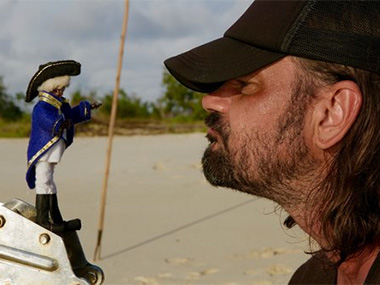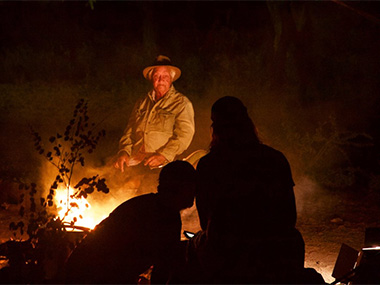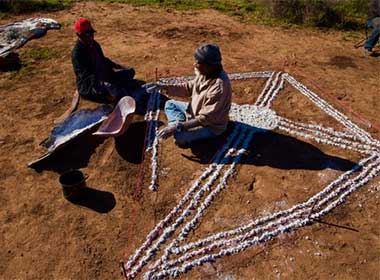THAT BIG FELLAR UP THERE

Film-maker Warwick Thornton challenges a bush toy version of Captain Cook
Posted by Jeremy Eccles | 12.06.17
“That Big Fellar.....” is none other than the Southern Cross, the 5 stars that grace the sky in the Southern Hemisphere, and feature on our national flag (or flags, if you're a devotee of the Eureka flag). Well, that's what we think – we, the colonial masters. But how often have you wondered whether the First Peoples of this land had any thoughts about the Southern Cross? Whether all those dark nights spent lying on the ground and looking up into the black immensity had resulted in any ideas about astronomy – or astrology?
Wonder no more! For that great film-maker (and cinematographer) Warwick Thornton (of 'Samson & Delilah' fame) has set out to bring the Aboriginal view of the sky down to earth, and being the trickster he is, he's chosen to do it via a juxtaposition with the extreme manipulation of the Southern Cross by the sorts of people who headed for Cronulla Beach one fine summer day with those 5 stars tattooed on to their ultra-white skin. Along for an extremely lively ride is Brendan Fletcher (of 'Mad Bastards' notoriety) as producer and occasional restrainer.
“Handmade” was the game plan as the pair set out to make this documentary feature film for the NITV 'Moment in History' series, intending to celebrate the 50th anniversary of the Referendum. They had just over a year – and “hand made” was as much a necessity as a known genre of film-making. And a significant admission by Thornton at the Sydney Film Festival forum where 'We Don't Need a Map' (an unfortunate match for the recent, much-travelled Martu art exhibition of the same name) was launched upon an unsuspecting world, was, “I didn't know those (Aboriginal) sky stories before the film”.
But being an open-minded man (rather than a gate-keeper), he went to the elders in Arnhemland, into Lightning Brothers country around Katherine, and back into the Eastern Deserts of his own ancestry to listen to the story-keepers. In the first, he learnt from Dr Djiniyini Gondarra of the sacred canoe that brought the Yolngu ancestors from the east and carries the spirits of the dead safely away. In the second he discovered the “Big Fellar up there” from Bill Harney (the Wardaman man who co-authored 'Dark Sparklers' about his people's astronomy), none other than Baime, the great Emu god who crops up in theology all over Australia. Why have white eyes never spotted that emu, when some people manage to see a crab, a bear and a lion? And in the Desert, he found his film's title as Harry Jagamarra Nelson and Robin Japanangka Granites both made (and unmade) their secret-sacred celestial symbol – literally a cross, by the way, not just its outline – out of warmalu/plant fluff in the desert sands. “We don't need a map – the song is the map”, the old Warlpiri men told Thornton by way of mnemonic route-finding.
In the Desert, the film-makers also discovered bush toys. And these works of Eastern Arrernte recycling – mainly the copper wiring from discarded motor vehicles – became a central motif for the film. Many a serious or ironic point is made by Thornton, down on his knees in the sand, animating tiny windmills, stockmen or Captain Cook as puppets to illustrate his argument. A wonderful variation on US doco-maker Michael Moore's use of animation.
But I had a tiny problem here! As someone close to the man who designed the original Southern Cross windmill in 1903, I was aware that it was all too easy to use that name to make the extreme case that the windmill was the prime colonial tool to 'tame' the land and extract water, heedless of Aboriginal systems and needs. Whether you can go so far as to blame the windmill for “denying the humanity of the Country as a sentient being, in kinship with the people”, as was claimed, I beg to doubt.
However some balance was also offered as Robin Granites and Harry Nelson commiserated with a fallen Southern Cross mill - “Poor old girl” - and climbed metaphorically back on to their one-time stock horses to admit, “They changed the country proper”.
No balance on the central point that arose from an incautious suggestion by Warwick Thornton, way back, that events like the Cronulla Beach riots were setting the Southern Cross “on a journey to become the new Swastika”. “We set out to do a shit-load of interviews on that subject”, Thornton described the team's methodology; “but no racists”. So we get astronomers and authors, rappers and tattoo artists, ad men and academics all agreeing that John Howard was so wrong in seeing “no racism” at Cronulla, while rapper and author Omar Musa brought things up to date by seeing the star-set as “a danger to me” in this age of terrorism fearfulness. But then Warwick Thornton admitted that the right-wing shock-jock reaction to his swastika comment had “scared the shit out of me” - fear turning to anger, and anger (unlike both sides at Cronulla) turning into the positive energy that engendered the film.
And if you get nothing else out of the film, do note that light pollution makes it so much harder for urban astronomers to actually see the Southern Cross than it is for remote Elders. And wonder at the Wauthrong Elder, Reg Abrahams revealing a rock solstice calendar almost certainly older than Stonehenge. And delight in Thornton's recreation of the Eureka Stockade at a kid's playground. But perhaps question whether we were really given the best possible sighting of that central figure, the Big Fellar in the night sky?
SBS will be showing 'We Don't Need a Map' on 23 July, there are hopes of a cinema release in early 2018 and plans to get it into schools across the country.
URL: https://www.wedontneedamapmovie.com
Share this:
»  del.icio.us
»
del.icio.us
»  Digg it
»
Digg it
»  reddit
»
reddit
»  Google
»
Google
»  StumbleUpon
»
StumbleUpon
»  Technorati
»
Technorati
»  Facebook
Facebook
Contact Details

Bill Yidumduma Harney yarns around the fire as the silhouette of Warwick Thornton looks on

Harry Jagamarra Nelson and Robin Japanangka Granites create a sand-painting of the Southern Cross in desert warmalu
Further Research
Artists: Bill Harney | Harry Jagamarra Nelson | Robin Japanangka Granites
News Tags: Baime | Brendan Fletcher | Cronulla riots | Jeremy Eccles | Samson & Delilah | Southern Cross | Southern Cross windmill | Sydney Film Festival | Warwick Thornton
Exhibition Archive
- 16.03.18 | SPECIAL REQUEST
- 20.02.18 | Gapu-Monuk – Saltwater Barks
- 16.02.18 | SONGLINES SYMPOSIUM
- 06.02.18 | SONGLINES – TRACKING THE SEVEN SISTERS
- 31.01.18 | Dennis Nona Emerges in Hobart
- 30.11.17 | Great Artists, Great Stories, Limited Time
- 27.11.17 | Moodoonuthi - 'Little One'
- 24.11.17 | 20% Off until End November
- 23.11.17 | THE APY LANDS COME TO SYDNEY
- 14.11.17 | Entries Open for 2018 NATSIAAs
- 01.11.17 | PAINTING COUNTRY
- 23.10.17 | The Scholls Donate Half their Art
- 10.10.17 | TARNANTHI 2017
- 11.08.17 | Natsiaas 2017
- 20.07.17 | APY ART DOMINATES THE WYNNE
Advertising

